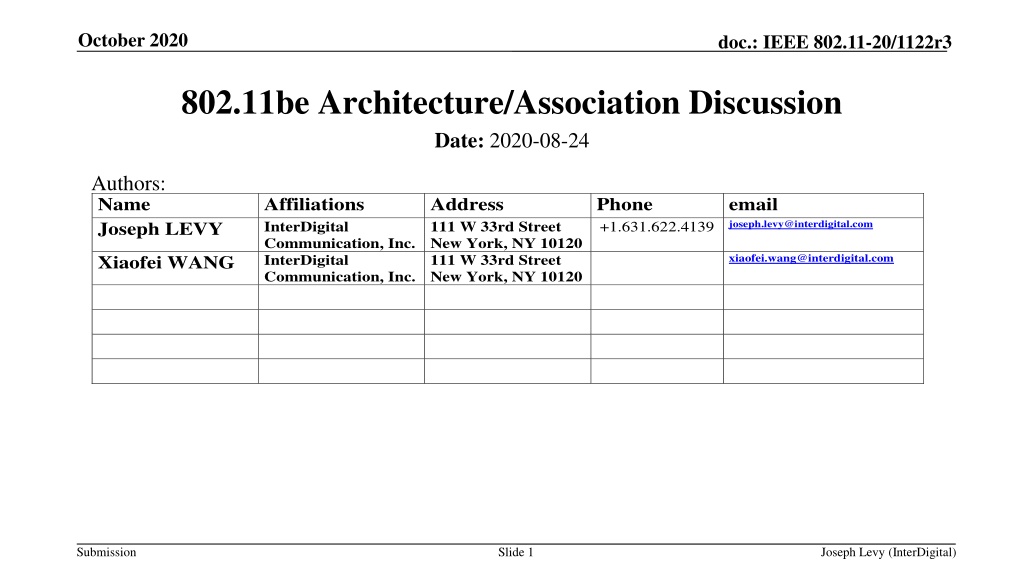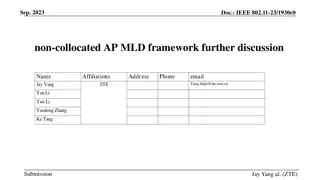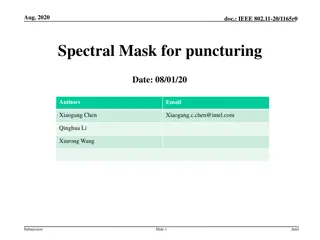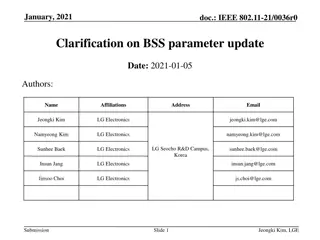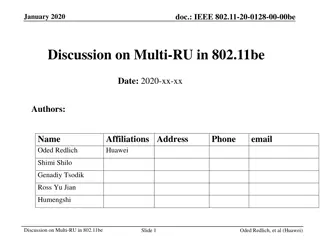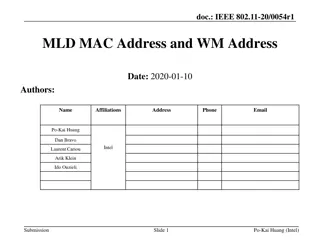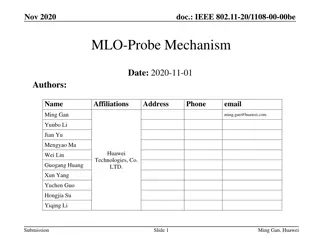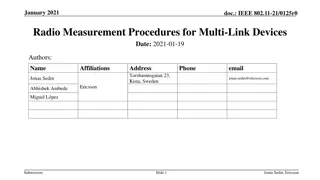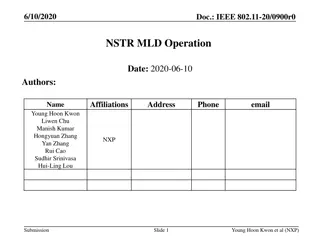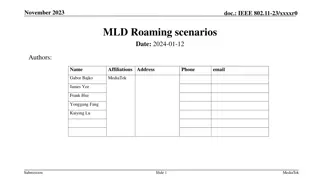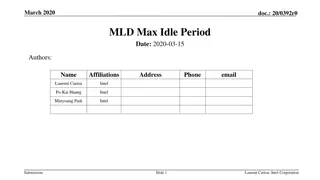Discussion on IEEE 802.11be MLD Architecture Alignment
IEEE 802.11 TGbe is exploring MLDs within the 802 architecture, focusing on aligning MLD operations with existing 802.11 features for enhanced compatibility. The MLD architecture aims to facilitate the flow of data between MAC SAPs and PHY SAPs, extending the current framework for APs and non-AP STAs. Emphasis is placed on utilizing and adapting established 802.11 functions to support MLD functionality effectively.
Download Presentation

Please find below an Image/Link to download the presentation.
The content on the website is provided AS IS for your information and personal use only. It may not be sold, licensed, or shared on other websites without obtaining consent from the author. Download presentation by click this link. If you encounter any issues during the download, it is possible that the publisher has removed the file from their server.
E N D
Presentation Transcript
October 2020 doc.: IEEE 802.11-20/1122r3 802.11be Architecture/Association Discussion Date: 2020-08-24 Authors: Name Joseph LEVY Affiliations InterDigital Communication, Inc. InterDigital Communication, Inc. Address 111 W 33rd Street New York, NY 10120 111 W 33rd Street New York, NY 10120 Phone +1.631.622.4139 email joseph.levy@interdigital.com Xiaofei WANG xiaofei.wang@interdigital.com Submission Slide 1 Joseph Levy (InterDigital)
October 2020 doc.: IEEE 802.11-20/1122r3 Abstract 802.11 TGbe has been discussing MLDs for several months, but there has been little discussion of how MLD will fit in the 802 architecture. Top down design concepts may help progress the MLD work. This contribution discusses an MLD architecture that is well aligned with the current 802.11 basic architecture and will hopefully allow many existing 802.11 features to be reused to support MLD operation. R3 updated and refocused based on TGbe decisions and ARC SC discussions. Submission Slide 2 Joseph Levy (InterDigital)
October 2020 doc.: IEEE 802.11-20/1122r3 Basic 802.11 Architecture/Association for Infrastructure (review) Both the AP and non-AP STA are logical entities 802.11 defines a link as link: In the context of an IEEE 802.11 medium access control (MAC) entity, a physical path consisting of exactly one traversal of the wireless medium (WM) that is usable to transfer MAC service data units (MSDUs) between two stations (STAs). [1] 802.11 based devices provide a service to higher layer entities enabling the exchange of information (MPDUs) via the 802.11 MAC SAP Association defines a SAP to SAP connection (a data link) between an AP MAC SAP to a non-AP MAC SAP to enable the transfer of MSDUs. Reassociation redefines a SAP to SAP connection to either the same or a different AP MAC SAP, while maintaining some association status (e.g. security/IP address). Disassociation is a means of tearing down a SAP to SAP connection. 802.11be should use/align with these existing functions/definitions as much as possible. Slide 3 Submission Joseph Levy (InterDigital)
October 2020 doc.: IEEE 802.11-20/1122r3 802.11be MLD Architecture Discussion The introduction of the MLD concept will define an MLD MAC SAP [2] An MLD MAC SAP of an AP MLD will connect to higher layers via the DS (for non-GLK APs) serving the same purpose as the current MAC SAP The MLD MAC SAP of an non-AP MLD STA will connect to higher layers via the LLC sublayer, also serving the same purpose as the current MAC SAP. The MLD MAC (lower and upper) will manage all aspects of MSDU/MPDU flow between the MAC SAP and the PHY SAP(s) The MLD PHY(s) will manage all aspects of MPDU/PPDU flow between the PHY SAP(s) and the wireless media This architecture is an extension of the current 802.11 architecture for STAs (AP and non-AP STA) Submission Slide 4 Joseph Levy (InterDigital)
October 2020 doc.: IEEE 802.11-20/1122r3 OSI Reference Model 802 Reference Model Review [3] 802.11 MAC service access point 802.11 PHY service access point 802.11 An 802 data link is from one LSAP to its peer LSAP Likewise an 802.11 data link is from one 802.11 MAC SAP to its peer MAC SAP Submission Slide 5 Joseph Levy (InterDigital)
October 2020 doc.: IEEE 802.11-20/1122r3 IEEE Std 802.1AX Link Aggregation [4] 802.11 MAC service access point 802.1 has completed 802.1AX, published 30 Jan 2020. The 802.1AX aggregates: One or more parallel instances of point-to-point links to be aggregated together to form a Link Aggregation Group (LAG) so that a Link Aggregation Client can treat the LAG as if it were a single link. This is done at the LLC layer. Therefore MLO should not simply aggregate 802.11 non-AP and AP STAs at the MAC SAP layer. Submission Slide 6 Joseph Levy (InterDigital)
October 2020 doc.: IEEE 802.11-20/1122r3 Current Basic 802.11 Data Plane Architecture (non-GLK) Local Higher Layer Entities 802.1x PAE 802.1x PAE 802.11 non-AP STA 802.11 AP STA LPD/EPD LPD/EPD LPD/EPD 802.1AC convergence function 802.1AC convergence function 802.1AC convergence function DA address filtering DSAF Distribution System (DS) (U) (C) (DS SAP) (U) (C) IEEE 802.1X Controlled and Uncontrolled Port Filtering (Optional) (M) IEEE 802.1X Controlled and Uncontrolled Port Filtering (Optional) (M) MAC (P) MAC 802.11 STA 802.11 STA (P) PHY PHY MAC SAP PHY SAP Wireless Media Submission Slide 7 Joseph Levy (InterDigital)
October 2020 doc.: IEEE 802.11-20/1122r3 Proposed MLD 802.11be Data Plane Architecture Local Higher Layer Entities 802.1x PAE 802.1x PAE LPD/EPD LPD/EPD LPD/EPD 802.1AC convergence function 802.1AC convergence function 802.1AC convergence function DA address filtering DSAF Distribution System (DS) (U) (C) (U) (C) (DS SAP) IEEE 802.1X Controlled and Uncontrolled Port Filtering (Optional) (M) IEEE 802.1X Controlled and Uncontrolled Port Filtering (Optional) (M) Upper MLD MAC Upper MLD MAC MAC MAC 802.11 STA MAC SAP Lower MAC 1 Lower MAC 2 Lower MAC3 Lower MAC 3 Lower MAC 2 Lower MAC 1 (P) (P) (P) (P) (P) (P) PHY 1 PHY 2 PHY 3 PHY 3 PHY 2 PHY 1 PHY SAP Wireless Media Submission Slide 8 Joseph Levy (InterDigital)
October 2020 doc.: IEEE 802.11-20/1122r3 From 11-20/1639r1: MLD-level or per-AP/link-level Implications: - MLD: - - - - - - - - - - - - Per-link: - - 802.1X controlled/uncontrolled filtering RX/TX MSDU rate limiting A-MSDU aggregation/deaggregation ( bufferable MMPDUs need to inject into the stack here, so Action frames functions??) PS Defer Queuing Management frames: Authentication/Association/Reassociation Request/Response Sequence Number assignment Packet Number assignment/Replay detection Block Ack Buffering and Reordering MPDU Encryption/Decryption Duplicate Detection Control frames (RTS/CTS, Acks, NDP, etc.) Management frames: Beacon generation, Probe Request/Response, Submission Slide 9 Joseph Levy (InterDigital)
October 2020 doc.: IEEE 802.11-20/1122r3 (U) (C) IEEE 802.1X Controlled and Uncontrolled Port Filtering (optional) (M) From 11-20/1639r1: RX/TX MSDU Rate Limiting A-MSDU Aggregation (TX) / De-aggregation (RX) PS Defer Queuing (AP or IBSS STA only) So, something like: (null) Sequence Number Assignment (null) MSDU Integrity and Protection (optional) MLD-level Fragmentation (TX) / Defragmentation (RX) Packet Number Assignment Replay Detection (optional) SYNRA Receiver Filtering (null) Block Ack Buffering and Reordering (null) MPDU Encryption (TX) / Decryption (RX) and Integrity (optional) Duplicate Detection (null) Implementation choice Block Ack Scoreboarding (null) Address 1 address filtering Address 1 address filtering (null) (null) . . . MPDU Header + CRC Creation (TX) / Validation (RX) MPDU Header + CRC Creation (TX) / Validation (RX) Per-link-level A-MPDU A-MPDU Aggregation (TX) / De-aggregation (RX) Aggregation (TX) / De-aggregation (RX) Submission Slide 10 Joseph Levy (InterDigital)
October 2020 doc.: IEEE 802.11-20/1122r3 MLD Capability Goals 1. An MLD shall efficiently use/manage multiple PHY links: a) Data at the MLD MAC SAP can be efficiently moved to an associated MLD MAC SAP via multiple PHY links. Providing the 802.11 service to the LLC layer from a single MAC SAP. b) The point to point link established by Association is a data link between two MAC SAPs. c) Allowing the 802.11 MAC to manage the flow of frames via multiple PHY links will: i. Improve latency (via multi-channel access) ii. Improve throughput (via PHY link aggregation and multi-channel access) iii. Avoid the inefficacy of above the MAC SAP aggregation (dependance on higher layer management). 2. An MLD shall receive Legacy beacons and group addressed frames a) Legacy beacons are received on the PHY link they are transmitted on, the receiving non-AP MLD STA will know that the beacon information is for the associated MLD PHY link b) Legacy group addressed frames can be received and processed by the non-AP MLD STA, as any group addressed frame is processed, the MLD will know which group addressed frames it should receive, just as a STA is informed as to the group addressed frames it should receive. Submission Slide 11 Joseph Levy (InterDigital)
October 2020 doc.: IEEE 802.11-20/1122r3 Current Concerns w/ MLD terms and concepts 1. The use of AP in MLO: a) An 802.11 AP is an 802.11 STA connected via a DSAF to a DS an AP has a MAC SAP and a wireless media interface. b) Currently an AP MLD is defined as: A MLD, where each STA affiliated with the MLD is an AP , each AP has a MAC SAP and the MLD has one MAC SAP to LLC This definition is not consistent with itself. 2. The use of non-AP STA in MLO: a) An 802.11 non-AP STA is a STA with a MAC SAP and a wireless media interface. b) Currently a non-AP MLD is defined as: A MLD, where each STA affiliated with the MLD is a non-AP STA . This definition also not consistent with itself, as each STA has a MAC SAP. Using these definitions for an AP MLD and a non-AP MLD STA create new 802.11 entities hence their behavior needs to be defined throughout the specification. Submission Slide 12 Joseph Levy (InterDigital)
October 2020 doc.: IEEE 802.11-20/1122r3 Proposed Way Forward Define an AP MLD as an AP this will: 1. Allow an AP MLD to support all existing AP behavior/features with minimal specification changes. 2. Where AP MLD requirements must be or are desired to be different than current AP behavior, e.g. PS or multiple PHY link management, new requirements/behavior can be specified. Define a non-AP MLD STA as a non-AP STA this will: 1. Allow a non-AP MLD STA to support all existing non-AP STA behavior/features with minimal specification changes. 2. Where non-AP MLD STA requirements must be or are desired to be different than current non-AP STA behavior new requirements/behavior can be specified Submission Slide 13 Joseph Levy (InterDigital)
October 2020 doc.: IEEE 802.11-20/1122r3 Straw Polls SP1: The definition of a MLD AP should be changed in the draft spec and the SFD to clearly state that an MLD AP is an AP. (Having a single MAC SAP.) Yes/No/abs SP2: The definition of a non-AP MLD STA should be changed in the draft spec and the SFD to clearly state that a non-AP MLD STA is a STA. (Having a single MAC SAP.) Yes/No/abs Submission Slide 14 Joseph Levy (InterDigital)
October 2020 doc.: IEEE 802.11-20/1122r3 Other Concerns w/ MLD terms and concepts 1. The use of the term link : a) In 802.11 and 802 the term link is used to describe a SAP to SAP (MSAP or LSAP, respectively) connection, a data/networking link. b) In MLO the term link is being used to describe an RF link , a PHY to PHY connection via the wireless media. This use is consistent with link budgets and other RF uses of link . I suggest changing from multi-link to multi-PHY or multi-PHY-link. 2. The use of the term device : a) device is defined in [5] as: mechanism or piece of equipment designed to serve a purpose or perform a function this is in line with the way 802.11 uses the term b) In 802.11 the term device is a physical entity not a logical entity like an AP or STA I suggest not using the term device to describe the MLO logical entities (e.g. AP/STA) Submission Slide 15 Joseph Levy (InterDigital)
October 2020 doc.: IEEE 802.11-20/1122r3 Straw Polls (cont.) SP3: Rename multi-link to: 1. multi-PHY (MPHY) yielding MPHYO, MPHY AP, non-AP MPHY STA 2. multi-PHY-link (MPL) yielding MPLO, MPL AP, non-AP MPL STA 3. Do not change the name: multi-link keeping MLO, MLD, MLD AP, non-AP MLD STA. (note MP is already used in 802.11: MP: mesh protocol) 1, 2, or 3 SP4: Agree that the term device should not be used to describe a logical entity. Yes/No/abs Submission Slide 16 Joseph Levy (InterDigital)
October 2020 doc.: IEEE 802.11-20/1122r3 Beyond Point to Point Data Plane Services While point to point data plane services are essential to 802.11 there are other services/functions and how MLO uses/receives legacy transmissions is critical. a) Beacons are essential for infrastructure deployments, multiple-beacons and beacon bloat are critical issues. MLO information must be available in legacy beacons. An MLD should receive legacy beacons. b) Group addressed MSDUs There should be no restriction on an MLD receiving legacy transmissions, MLDs can receive PPDUs with multiple addresses. c) Security the P2P data link for MLD must be secure, hence the data link should be secured by pairwise security and this security should not be weakened by reuse. Submission Slide 17 Joseph Levy (InterDigital)
October 2020 doc.: IEEE 802.11-20/1122r3 Conclusion The proposed MLD architecture and suggestions: 1. Is a natural extension to the current 802.11 architecture 2. Allows the current association, reassociation, and disassociation services to be used to manage MLD connections 3. Allows for reuse of other defined 802.11 services/capabilities without changes throughout the entire 802.11 specification While these issues and other 802.11be architecture issues will continue to be discussed in the ARC SC, it is TGbe s responsibility define and agree the 802.11be architecture and terminology. Hopefully, this contribution will help focus the TGbe discussions and assist TGbe in reaching a consensus on how to progress MLO. Submission Slide 18 Joseph Levy (InterDigital)
October 2020 doc.: IEEE 802.11-20/1122r3 References [1] Draft P802.11REVmd D5.0 [2] 11-200566r78 Compendium of straw polls and potential changes to the Specification Framework Document [3] IEEE Std 802-2014 IEEE Standard for Local and Metropolitan Area Networks: Overview and Architecture [4] IEEE Std 802.1AX-2020 IEEE Standard for Local and Metropolitan Area Networks Link Aggregation [5] ISO/IEC/IEEE 24765 second edition 2017-09 Systems and software engineering Vocabulary Submission Slide 19 Joseph Levy (InterDigital)
October 2020 doc.: IEEE 802.11-20/1122r3 BACK-UP SLIDES Submission Slide 20 Joseph Levy (InterDigital)
October 2020 doc.: IEEE 802.11-20/1122r3 Proposed MLD 802.11be Data Plane Architecture Local Higher Layer Entities 802.1x PAE 802.1x PAE LPD/EPD LPD/EPD LPD/EPD 802.1AC convergence function 802.1AC convergence function 802.1AC convergence function DA address filtering DSAF Distribution System (DS) (U) (C) (U) (C) (DS SAP) IEEE 802.1X Controlled and Uncontrolled Port Filtering (Optional) (M) IEEE 802.1X Controlled and Uncontrolled Port Filtering (Optional) (M) Upper MLD MAC (m) Upper MLD MAC (m) (m) (m) (m) (m) MAC MAC 802.11 STA Lower MAC 1 Lower MAC 2 Lower MAC3 Lower MAC 3 Lower MAC 2 Lower MAC 1 PHY 1 PHY 2 PHY 3 PHY 3 PHY 2 PHY 1 Wireless Media Submission Slide 21 Joseph Levy (InterDigital)
October 2020 doc.: IEEE 802.11-20/1122r3 FST Architecture For Reference Local Higher Layer Entities 802.1x PAE 802.1x PAE LPD/EPD LPD/EPD LPD/EPD 802.1AC convergence function 802.1AC convergence function 802.1AC convergence function DA address filtering DSAF Distribution System (DS) Non-AP AP (U) (C) (U) (C) (DS SAP) IEEE 802.1X Controlled and Uncontrolled Port Filtering (Optional) (M) IEEE 802.1X Controlled and Uncontrolled Port Filtering (Optional) (M) Transparent FST Entity Transparent FST Entity (M2) (M1) (M1) (M2) MAC MAC MAC Channel 2 MAC Channel 1 STA MAC Channel 1 MAC Channel 2 PHY Channel 2 PHY Channel 1 PHY Channel 1 Note for FST: Security keys, sequence counter, and PN counters are shared between Channel 1 and 2 entities PHY Channel 2 At any moment only one of the MAC SAPs (M1 or M2) is mapped to the MAC SAP of the FST STA (M) Wireless Media Submission Slide 22 Joseph Levy (InterDigital)
October 2020 doc.: IEEE 802.11-20/1122r3 Possible AP MLD/ Non-AP MLD Associations Assuming the architecture shown on the Proposed MLD 802.11be Architecture slide with an AP MLD that can support 3 links and a non-AP MLD that can support 3 links: The non-AP MLD can associate with: The AP MLD with 3 links The AP MLD with 2 links (there are 3 possible 2 link configurations) The AP MLD with 1 link (3 possible) this is standard current 802.11 association Therefore each of configuration needs an identifier (e.g. a MAC address) The identifier will be associated with a specific configuration, the configuration will provide the number and parameters of the links. The non-AP MLD will associate using the identifier to a specific configuration Hence the non-AP MLD only need to use association, reassociation, and disassociation services to manage its link configuration with the AP MLD. Submission Slide 23 Joseph Levy (InterDigital)
